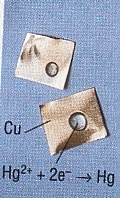Pre-trial
In chemistry, a preliminary test is a short test in the field of analysis that is carried out with a sample substance that has not been processed further and is mostly salt-like-solid in order to obtain information on any ingredients (anions / cations) that may be present. These qualitative detection reactions do not yet have the character of proof, but provide information for the search for ions in the cation separation process .
A distinction is made between evidence of cations and evidence of anions in preliminary samples :
Preliminary tests for cations

The preliminary tests for cations include:
- the flame test for alkali and alkaline earth cations (pictures above),
- the luminous test for tin salts ,
- the Marsh test for arsenic - and antimony salts ,
- the amalgam sample for mercury salts ,
- the cross match for ammonium salts ,
- the oxidative melt as an indication of chromium and manganese salts and
- the phosphorus salt pearl and borax pearl as an indication of different heavy metal salts.
If you bring the unknown sample on a magnesia stick into the non-luminous flame of the Bunsen burner , the flame changes color when certain ions are excited by the flame (flame test, see figures below). The excited electrons fall back to their normal energy level ( quantum jump ), releasing the absorbed energy in the form of a light quantum. The wavelength of this light beam provides information about which electron in which energy level ( atomic orbital ) or atom has made the quantum leap (the technical form of this analysis method is called atomic emission spectroscopy , abbreviation: AES).
The luminous probe and the Marsh probe work on a similar principle, but the luminous phenomenon here is due to a chemiluminescence burning stannane , the formation of the arsenic or antimony level in the Marsh probe to the thermolysis (the decomposition in heat) of the arsine gas.
For the amalgam sample, a little sample solution is placed on a sheet of copper. In the presence of mercury ions , a silvery amalgam stain is created ( redox reaction ).
The oxidation melt is a redox reaction . Here the sample is melted in the crucible with three times the amount of a mixture of soda and saltpetre . The latter is able to oxidize manganese salts to blue-green manganate and chromium salts to yellow chromate (see figure on the right).
The cross match is a short test in which moistened caustic soda is allowed to act on a sample. In the presence of ammonium ions , the sodium hydroxide solution reacts to form ammonia gas , which is indicated by moistened universal indicator paper (UIP) ( indication of an acid-base reaction ).
The borax and phosphorus salt pearl is produced with the help of sodium tetraborate ( borax ) or sodium ammonium hydrogen phosphate ( phosphorus salt ) in the burner flame. If the substance to be examined contains certain cations, the salt bead then shows characteristic colors (example: deep blue in the presence of cobalt ions, see illustration at the beginning of this article).
Lithium , carmine
Sodium , sodium yellow
Potassium , purple
Calcium , brick red
Strontium , red
Copper , green, also blue-green (turquoise)
Preliminary tests for anions
The preliminary tests for anions include:
- the creep test for fluoride ions,
- the sulphide detection with acid and lead acetate paper,
- the carbonate detection with acid and lime water,
- the Acetatnachweis by trituration with potassium hydrogen sulfate (as an odor sample).
For the creep test , a small amount of the substance to be examined is placed in a test tube together with concentrated sulfuric acid. If the sample contains fluoride, hydrofluoric acid (formula: HF) is formed, which etches the glass wall and appears to creep up it.
A variant of this verification is when the sample is brought together in a porcelain crucible with a little sulfuric acid and sand ( silicon dioxide , quartz ). In this case, the hydrogen fluoride reacts with silicon dioxide to form gaseous silicon tetrafluoride. This gas rises and reacts with a drop of water that has been placed on a piece of black paper hanging above the crucible. During this process, water and silicon tetrafluoride are converted back into hydrogen fluoride and silicon dioxide. The latter forms a white spot on the black paper and indicates fluoride.
The evidence of the ions sulfide, carbonate and acetate are acid-base reactions : Added strong acids displace the weaker acid (hydrogen sulfide from sulfide, carbonic acid from carbonate and acetic acid from acetate) from its salt (displacement reaction ):
The hydrogen sulfide is detected with lead acetate paper (blackening), the carbon dioxide with lime water (white cloudiness) and the acetic acid by a careful odor test. If the sample contains sulphide at the same time, it must be rubbed with hydrogen peroxide in addition to the potassium hydrogen sulphate so that the toxic hydrogen sulphide is oxidized to the non-toxic sulphate ( interference suppression of a detection reaction ).
literature
- J. Strähle, E. Schweda: Jander · Blasius - Introduction to the inorganic-chemical practical course. 14th edition. Hirzel, Stuttgart 1995, ISBN 978-3-7776-0672-9 .



